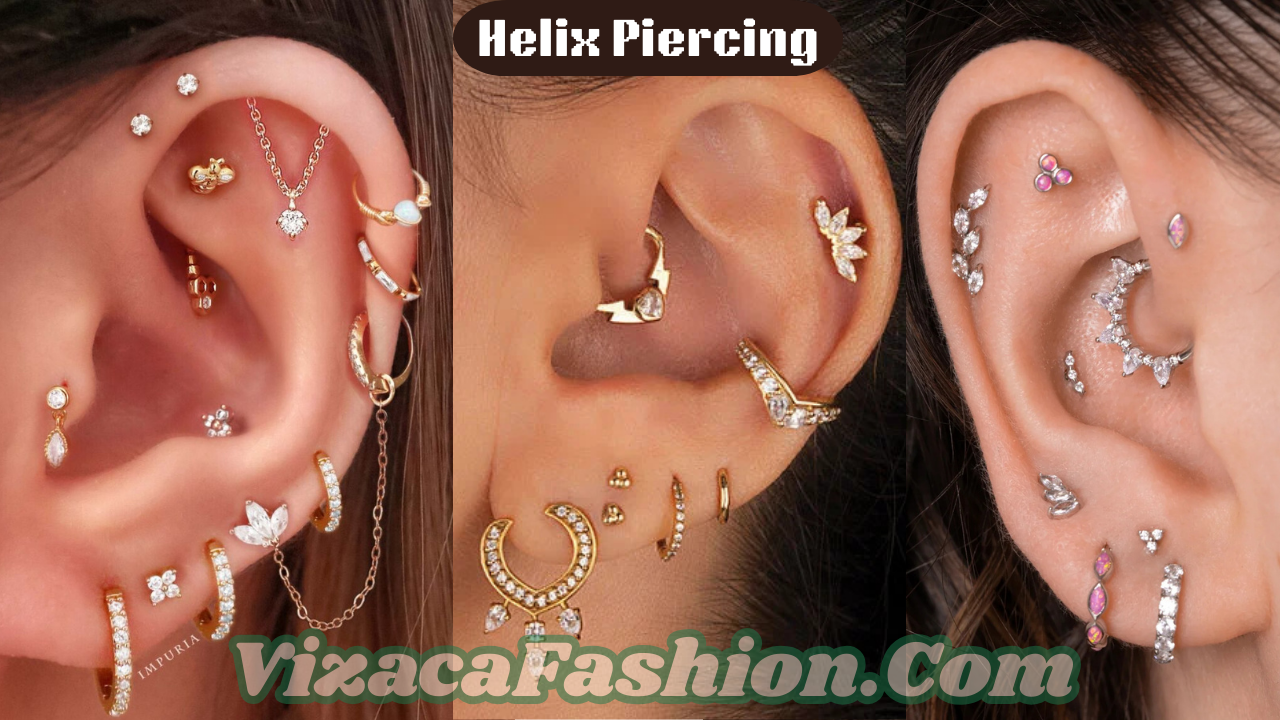Helix piercings have become a popular fashion statement in recent years, offering a stylish way to express individuality. Positioned on the upper cartilage of the ear, helix piercings offer endless customization possibilities, ranging from single piercings to intricate designs like forward helix and double helix piercings. Whether you’re a piercing enthusiast or considering your first cartilage piercing, this detailed guide will cover everything you need to know about helix piercings, their variations, and the best jewelry choices.
What Is a Helix Piercing?
A helix piercing is a type of ear piercing located in the upper cartilage area of the ear. Unlike traditional earlobe piercings, helix piercings involve puncturing the cartilage, which makes the process slightly more complex. Helix piercings are highly versatile and can be placed anywhere along the helix curve, allowing for diverse placement options and styles.
Key features of helix piercings include:
- Customization: Choose between a single helix, forward helix, or double helix piercing.
- Healing Time: Cartilage piercings take longer to heal, typically 6-12 months.
- Jewelry Variety: Options range from simple studs to elaborate hoops and barbells.
Forward Helix Piercing: A Stylish Variation
A forward helix piercing is positioned at the front curve of the ear, near where the helix meets the face. This placement is particularly eye-catching and works well with subtle or bold jewelry designs.
Why Choose a Forward Helix Piercing?
- Unique Appearance: Forward helix piercings are less common than standard helix piercings, making them stand out.
- Versatility: You can choose one, two, or three piercings in the forward helix area for a stacked look.
- Jewelry Choices: Delicate studs, gemstones, and hoops are popular choices for forward helix piercings.
Healing Tips for Forward Helix Piercings:
Due to the placement, forward helix piercings require extra care to avoid irritation. Clean the area daily with a saline solution and avoid sleeping on the piercing to reduce pressure.
Double Helix Piercing: A Trendy Option
For those seeking a bolder look, the double helix piercing involves two piercings placed along the upper ear cartilage. This style offers symmetry and balance, making it a favorite among piercing enthusiasts.
Advantages of Double Helix Piercings:
- Layered Aesthetic: The double helix piercing allows you to mix and match jewelry for a dynamic appearance.
- Creative Freedom: Combine different jewelry types, such as studs and hoops, to customize your look.
- Enhanced Style: This piercing pairs beautifully with other ear piercings, creating a curated ear look.
Considerations for Double Helix Piercings:
- Ensure that both piercings are evenly spaced for a balanced appearance.
- Healing time may be slightly longer since you’re caring for two piercings at once.
Types of Helix Piercing Jewelry
Choosing the right jewelry is essential for both aesthetics and comfort. Helix piercing jewelry comes in a variety of styles, materials, and sizes to suit every preference.
Popular Helix Piercing Jewelry Options:
- Studs: Simple and elegant, studs are a classic choice for helix piercings.
- Hoops: Small hoops add a trendy and minimalist touch to your look.
- Barbells: Straight or curved barbells are perfect for forward helix or double helix piercings.
- Gemstones: Add a sparkle with jewelry featuring diamonds, crystals, or other gemstones.
Materials to Consider:
- Titanium: Hypoallergenic and ideal for sensitive skin.
- Surgical Steel: Durable and affordable.
- Gold: Adds a luxurious touch, but ensure it’s at least 14k to avoid irritation.
Helix Piercing Procedure: What to Expect
Understanding the piercing process can help ease any nerves and ensure you’re prepared.
Step-by-Step Helix Piercing Process:
- Consultation: Discuss placement and jewelry options with your piercer.
- Preparation: The area is cleaned and marked for precise placement.
- Piercing: Using a sterilized needle, the piercer carefully creates the hole.
- Jewelry Insertion: The chosen jewelry is inserted immediately after piercing.
The procedure is quick, but some discomfort may occur due to the cartilage’s toughness. Always visit a professional piercer with proper hygiene practices to minimize risks.
Aftercare for Helix Piercings
Proper aftercare is crucial for healing and preventing infections. Follow these tips for a smooth recovery:
- Clean Daily: Use a saline solution or non-alcoholic antiseptic to clean the piercing twice a day.
- Avoid Touching: Keep your hands away from the piercing to prevent introducing bacteria.
- Be Gentle: Avoid sleeping on the side of your piercing and handle it with care during grooming.
- Monitor Healing: Watch for signs of infection, such as redness, swelling, or discharge, and consult a professional if needed.
Pain and Healing Time for Helix Piercings
Helix piercings are generally considered low to moderate on the pain scale, depending on individual pain tolerance. The cartilage’s firmness makes the process slightly more uncomfortable than an earlobe piercing.
Healing Time Overview:
- Initial Healing: 6-8 weeks.
- Complete Healing: Up to 12 months.
Patience is key during the healing process. Avoid changing your jewelry too soon, as this can disrupt healing and lead to complications.
Helix Piercings as a Fashion Statement
Helix piercings offer endless possibilities for personal expression. From forward helix piercings to double helix piercings, each style adds a unique touch to your overall look. By experimenting with helix piercing jewelry, you can create a curated ear that complements your personality and fashion sense.
Whether you opt for a single stud, a sparkling gemstone, or a series of hoops, helix piercings allow you to mix and match designs effortlessly. The combination of versatility and individuality makes helix piercings a timeless choice in the world of body art.
FAQs
1. What is the difference between a forward helix and a double helix piercing?
A forward helix piercing is located at the front curve of the ear, near the face, while a double helix piercing involves two piercings along the upper cartilage.
2. How long does it take for a helix piercing to heal?
Healing times vary but generally range from 6 to 12 months. Proper aftercare is essential for a smooth recovery.
3. Can I sleep on my helix piercing?
It’s best to avoid sleeping on the side of your piercing until it’s fully healed to prevent irritation and pressure.
4. What is the best jewelry for helix piercings?
Studs, hoops, and barbells made of hypoallergenic materials like titanium or surgical steel are ideal choices for helix piercings.
5. Are helix piercings painful?
Pain levels vary by individual but are generally considered low to moderate. The firmness of the cartilage may cause slight discomfort during the procedure.


